Thanks to a conscious decision by the Kerala Tourism Development Corporation at the turn of the century, this little patch of the south-west coast of India is well and truly on the map. The marketing of its backwaters – with mountain plantations, wildlife sanctuaries, heritage sites and two world-class beaches all thrown in – is underscored by the cartoon emblem you see everywhere of houseboat and palm tree above the legend “God’s Own Country”. In case you hadn’t spotted the sell, Kerala is the chilled and cultured alternative to Goa for the slightly more sophisticated visitor.
There’s truth in it too. A useful primer is Arundhati Roy’s 1997 Booker Prize Winner, The God Of Small Things, which is set here. Even during the high season of December and January, especially after the Indian schools have gone back, when it is a dry and balmy 30-odd °C all day every day, you can find plenty of places away from the crowds.
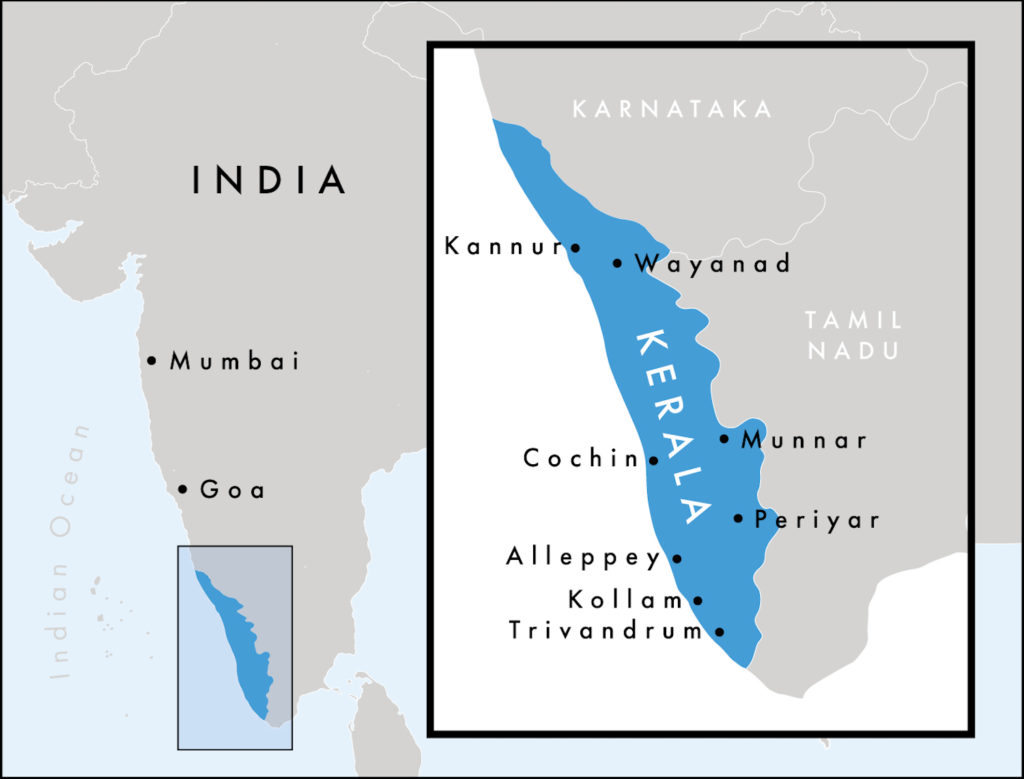
Vasco da Gama pitched on this land in 1498, triggering the Portuguese, then the Dutch, and then the British to battle the Arabs over the spice trade. Yet the state of Kerala was not actually created until 1956 and a year later the Malayalam-speaking Keralites put in the first freely elected communist government anywhere in the world. They have been in power frequently since, including today, and you will see occasional hammer-and-sickle flags and graffiti, especially in and around Trivandrum, the capital.
Kerala has the highest literacy rate in India; single-use plastics are banned; and the Hindu-nationalism of Narendra Modi and the BJP is robustly rejected. During my visit, there were not only regular public demonstrations against Modi’s 2019 Citizenship Act that grants the right of return to all religious groups apart from Muslims, who make up 14% of the country, but there were reported instances of Hindus choosing to marry in mosques in solidarity.
The North
Bekal and Kannur, the northern seaside fort towns separated by 80 kilometres of Malabar Coast that is dotted with slabs of palm-fringed golden-sands facing blood-red sunsets, are little visited. Although there are more dramatic destinations, there are plenty of remote homestays that give intimate insights into the local way of life.
The beaches tend to be rather rugged – the best is probably Thottada, just south of Kannur – and there are no facilities and almost no people on any of them. If you do venture onto them, make sure to cover up as northern Kerala is predominantly Islamic and deeply conservative. Goa, just 400km up the coast, could be a million miles away.
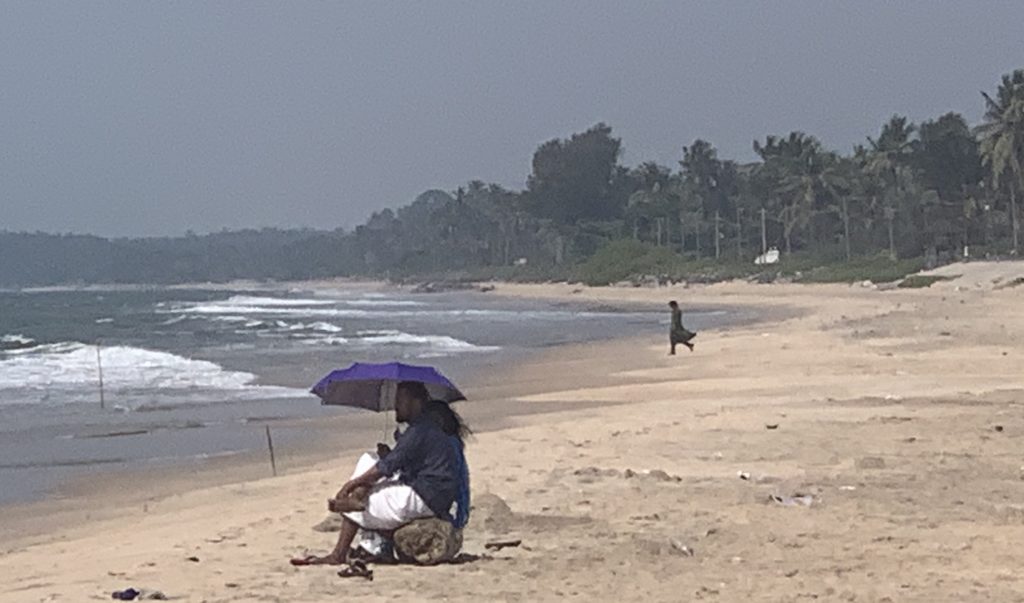
Kannur has a brand-new international airport, making it a good entry point for exploring Kerala top to bottom. It is also the home of theyyam, a Hindu spirt-possession ritual performed almost every day between November and April by travelling troops in the temple grounds of different villages in the region. Locals will tell you where and when tomorrow’s will be.
Solo dancers attired as gods, with red-painted faces, magnificent headgear, elaborate dresses and pointed swords, fall into trances around open fires to the loud beat of a dozen or more bare-chested drummers. This lasts for 90 minutes and then the “gods” offer blessings to queues of locals who have been watching. The experience is informal – you can see the dancers getting made up and into costume beforehand – and authentic. At the one I attended I was the only non-Indian present among the crowd of fifty or so.
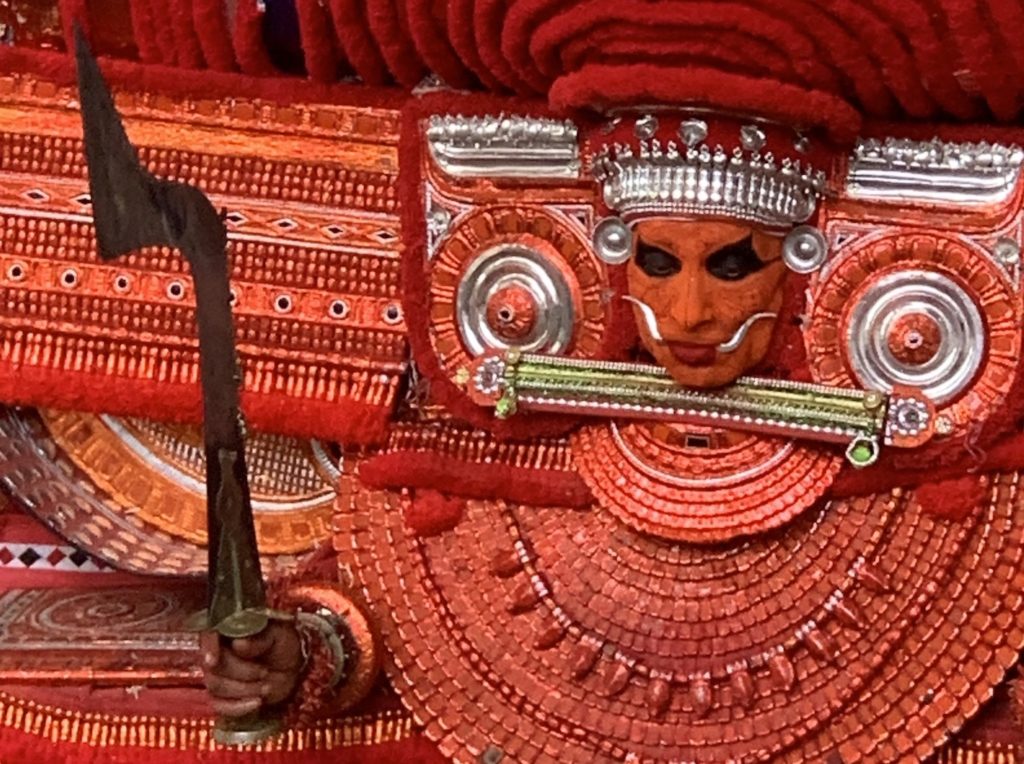
It is a three to four hour drive east from Kannur to Wayanad, and about the same coming back again to Calicut a little further south, winding beautifully up to a little over 2,000m around paddy fields, hills of stubby banana trees sharing space with lanky betel nut trees, tiers of tea bushes side-by-side with banks of coffee shrubs, with commanding plantation bungalows at their centre, orange groves, pepper vines, rubber trees and vanilla creepers as well as forests thick with palms and bamboo all around. No space is wasted, and the vistas are gorgeous.
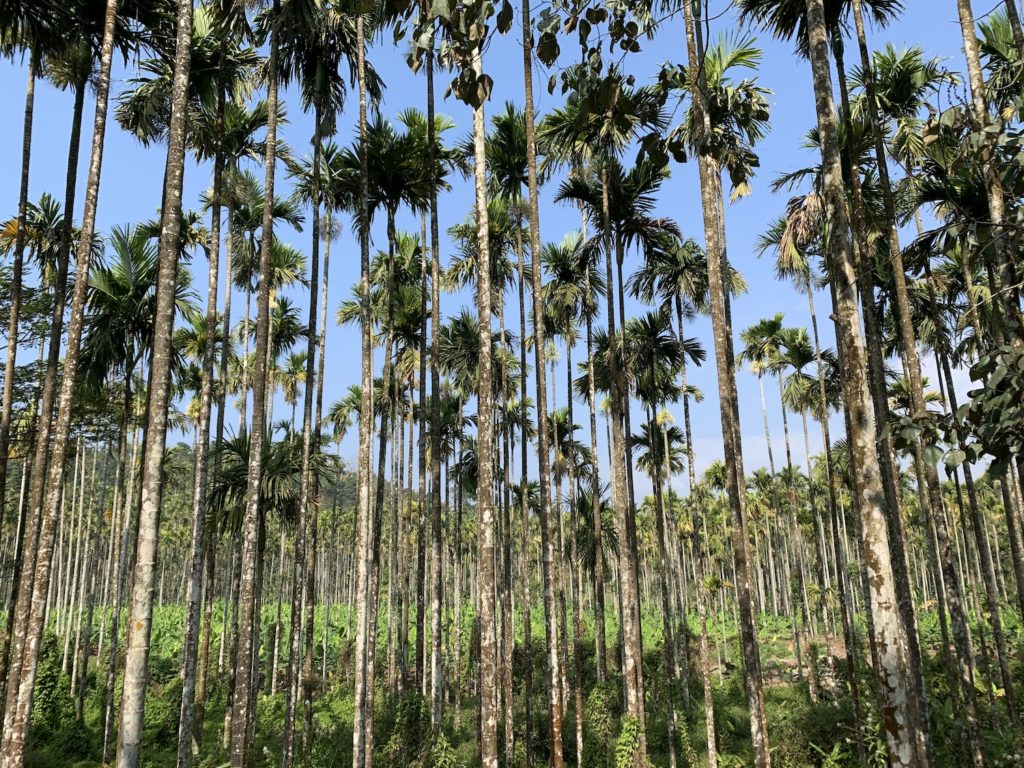
The Wayanad region is part of the Nilgiri Biosphere Reserve, which sprawls into the neighbouring states of Karnataka and Tamil Nadu. This in turn is in the Western Ghats mountain range – UNESCO-listed as one of the ten “hottest hotspots” for biological diversity on the planet – that stretches for 1,600km from Gujarat all the way down to the southern tip of the sub-continent.
Wayanad is serene and unspoilt, ideal for trekking and birding as well as accessing the eponymous Wildlife Sanctuary. This 350 sq km haven is home to peacocks, elephants, leopards and tigers amid the eucalyptus, and is toured by small green jeeps for an hour from 7 in the morning and again at 3 in the afternoon. There are only seven passengers allowed to squeeze into each tiny vehicle, which head off on rough tracks from two ticket offices: Tholpetty in the north and Muthanga in the east.
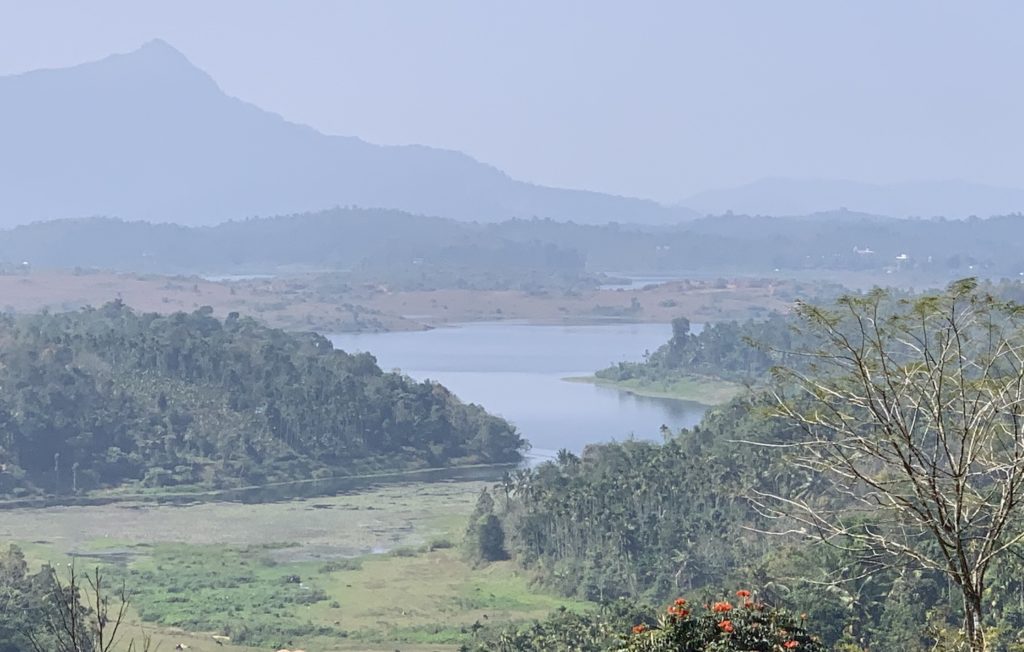
There are three main towns in the region – Kalpetta, Mananthavadi and Sultanbatheri – and lots of rural homestays. For top of the range you cannot do better than Victor and Ranjini at Amaryllis whose lovingly designed tree houses enjoy the constant twitter of the black-chinned laughing thrush among other species as well as spectacular panoramas over the forested hills, a beautiful reservoir and on to the sunset beyond.
Central
Trains run from as far north as Delhi down through the whole of Kerala to Trivandrum. It costs 70 rupees, less than €1, for the five-hour chug, by engines pulling more than twice the number of carriages as those in Europe, for the bit from Calicut to Cochin. It’s old and it’s slow and it’s exactly what you would want it to be. Dozens of ceiling fans whir away even though the windows and doors are jammed open for natural A/C. Acrobats and beggars, tea and coffee wallahs, bhaji and dosa hawkers, all pass through from time-to-time.
Cochin, as it is usually still called despite being formally localised recently to Kochi, is the self-styled “Queen of the Arabian Sea”. It is beautifully situated at the mouth of the Vembanad Lake on the northernmost estuary of the backwaters. The main area of interest is at the top of the upward-pointing most-westerly finger of land: the neighbourhoods of Fort Cochin in the north-west and Mattancherry in the east.
Fort Cochin has more than 200 homestays as well as several sumptuous heritage hotels, the pick of which are either side of Vasco da Gama Square: the colonial era buildings of Brunton Boatyard, facing right on to the water, and Old Harbour, with a huge mango tree in its courtyard around which villas are clustered. However, be warned that compared to the north this is tourist India, with a main drag along Princess Street that is chock full of pashminas, model black-and-yellow tuk-tuks, and much-needed anti-mosquito DEET, where traders yell at you even while, without irony, pointing to their signs declaring “hassle-free shopping”.
Da Gama first arrived here in 1502 and on his third visit died here in 1524. He was initially buried in St Francis Church, the first European church in India, though there is only a sad sign pointing to where his tomb once lay as his body was soon moved to Lisbon. The church is set back just behind the lovely paved promenade that runs for about half a kilometre from the Fort Kochi Beach, often crowded with locals in colourful sarees, though swimming is forbidden because of the undercurrent, past the tiny remains of the gunnery of the eponymous sixteenth century Fort Emmanuel and the grubby bit of sand that is Mahatma Gandhi Beach, through the outdoor fish market and along the Chinese Fishing Nets.
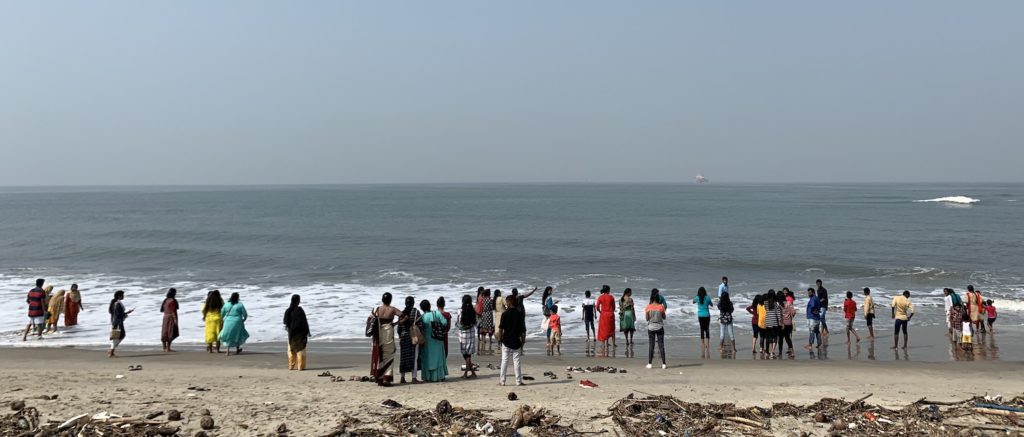
These nets have become a symbol of the entire backwaters in the Kerala tourist industry’s marketing push. There are others, notably around Kollam, though none so striking as these. There are eight or ten 20m2 sky-blue fishing-nets, at the end of long wooden gangplanks, that at high tide are lowered and heaved back up, thanks to the muscle power of at least half a dozen men at each. At low tide, fishermen wade into the shallows to fling smaller nets by hand, twirling like hammer-throwers in athletics.
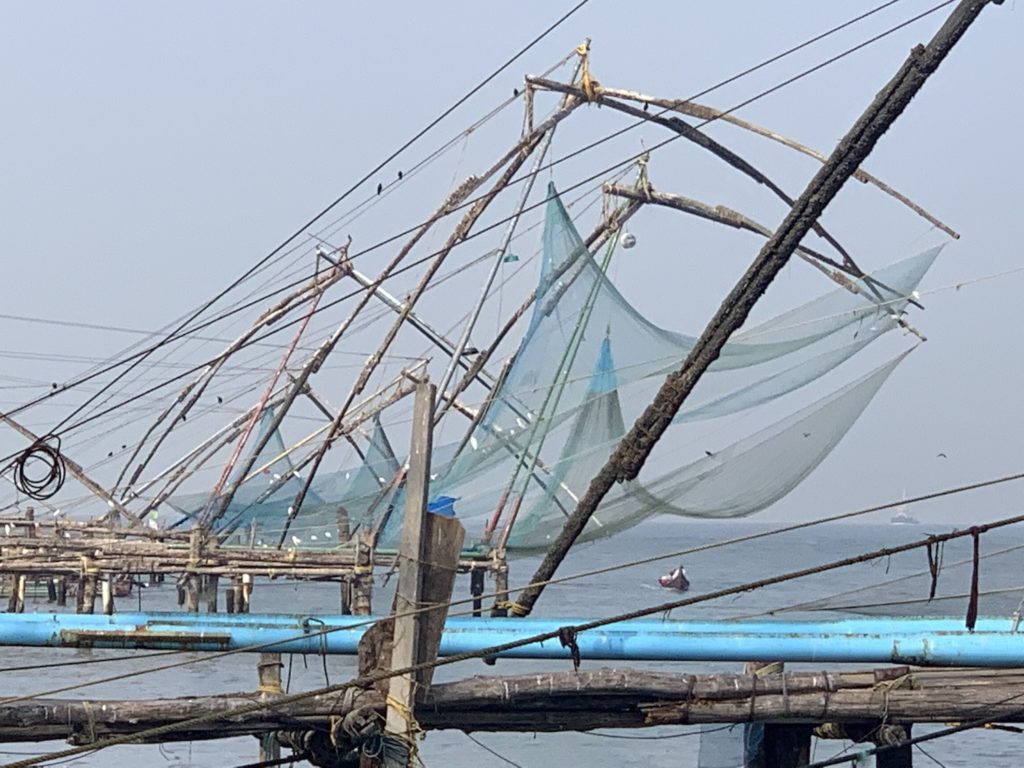
Mattancherry is renowned locally for its Dutch Palace (in fact built by the Portuguese) and the remaining institutions of what is called Jew Town, housing the tiny community descended from sixteenth century European colonialists: the 1568 Paresi Synagogue and nearby cemetery. There is also an enormous outdoor laundry that works for almost every guesthouse in the area and which looks like it has hardly changed in a thousand years.
Fort Cochin is home to two local art forms: Kalarippayat, a ritualistic martial art, an hypnotically dangerous mixture of gymnastics, wrestling and sword-fighting; and Kathakali, a heavily stylised form of classical music and dance that I found hard going. These days, both are performed for those tourists who cram into the cute 150-seat wooden Centre Theatre each afternoon.
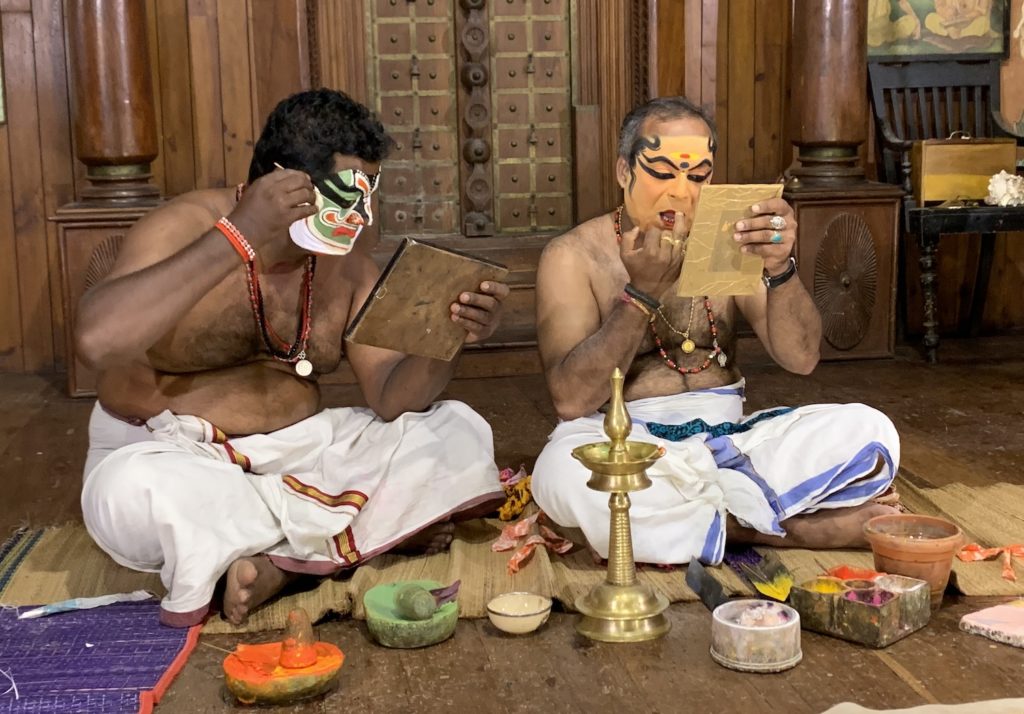
The Munnar region is bigger cousin to Wayanad and it is a four-hour cab ride from Cochin, through fields of avocados, cardamom, cinnamon, cloves, cocoa, ginger, lemongrass, nutmeg, papaya and pineapple on the lower slopes. As soon as you cross the mighty Periyar River, the longest in Kerala, it is very pretty, driving through untamed sandalwood forest and along avenues of eucalyptus leaning to meet above the newly tarmacked road, casting mottled shadows all about.
Munnar itself is a pleasant little town at 1,700m of one temple, one mosque, one church and one main road lined with shacks selling spices and tea. For it nestles in the higher climb among the immaculate hedgerows of vast tea plantations.

Up here it is breath-taking to wind around the sculpted fields patterned in waves on the slopes. Left wild, these hedges can reach 10m-high, but to simplify cultivation and stimulate leaf buds they are relentlessly manicured into flat-tops no more than 1m-tall. Erythrina, gliricidia and silver oak trees are planted among them for shade, though they also add glamour.
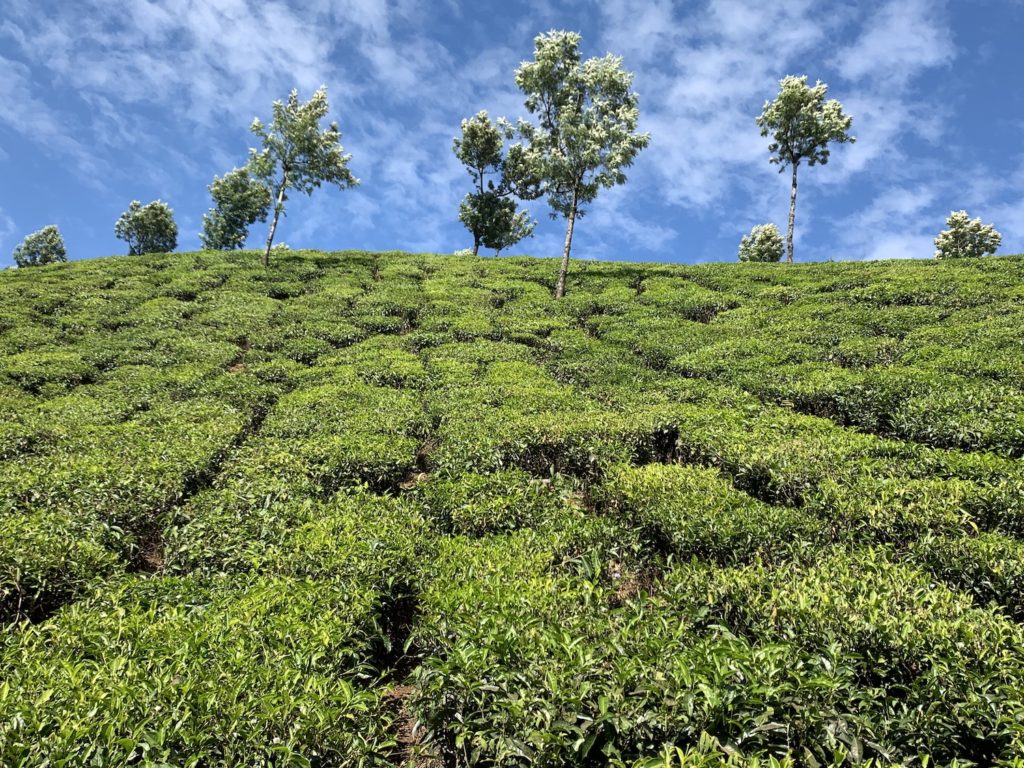
The bright green is occasionally spotted with colour from the rainbow-headgear of the tea-pickers. Most of these plantations are owned by corporate behemoths like the Tata Group, and labourers are paid the princely sum of 350 rupees or €4 a day to pick the new growth from bushes every 40 days all year round. No wonder that younger generations benefitting from rising education standards are increasingly fleeing to work in Bengaluru and Chennai.

During their three centuries in India, the British built hill stations high up to escape the heat. There is a Top Station 33km from Munnar, really no more than another viewing platform at the end of a short walk from the car park just over the border in Tamil Nadu. But it is worth coming because although it should take no more than two hours to drive, which is slow enough along the twists and turns, it can easily take twice that as you will want to stop on almost every corner to admire the views. You drive past the Mattupetty and Kundaly dams, and along roads marked with signs warning that elephants roam free in these parts.
There are plenty of humble homestays to choose from and they will all fix up treks through tea plantations and visits to the Eravikulam National Park, home of the endangered Nilgiri Tahr mountain goat and Neelakurinji plants that flower on mass only once every twelve years like clockwork (the next is not due until summer 2030). A typical one is the multi-award-winning Rose Gardens in Karadippara on the Cochin road 10km south-west of Munnar town, now in the hands of the third generation of the Pallattukunnel family.
The South
It takes three and a half hours for the cab to drive the 120km south along the Periyar River and the Western Ghats to the Periyar National Park, incongruously passing lots of billboards advertising steel pipes and uncrackable concrete, but typically involving lots of overtaking on blind bends.
This is South India’s most popular wildlife park because you can walk and raft among the animals. You are allocated gaiters, fetchingly worn over socks and trousers below the knee, for protection from leaches. It is much easier to spot a Great Hornbill, the state bird, than it is an elephant, and with only forty tigers spread across 300 sq km your chances of seeing one of those is close to zero. However, you will be accompanied on your trek by a ranger with a rifle, just in case.
The main base is the careworn town of Kumily, but there are homestays in the hills. A very good one is Coffee and Pepper Plantation Villa, ten minutes west of Kumily. Another option is to stay on an island in the park itself at the Lake Palace.

It is four hours back to the coast at Alleppey (now officially renamed Alappuzha, though nobody ever calls it that). The town, admittedly with some pretty waterways, is a scruffy maze that need not detain you long apart from at the beach. On weekend evenings, that is mayhem: alive with thousands of Indians, fully clad, including shoes and socks, watching the radiant sunsets, spilling into the busy road under the flyover, flooding the cafes and restaurants. They are not buying much alcohol though. Kerala banned it in 2014, and while prohibition was lifted in 2017 it is now available only at government-owned liquor stores, which are always hidden from sight above ground level, and are good fun to nose around. An oasis amid the chaos is Raheem Residency, a lovely heritage hotel facing the sand.
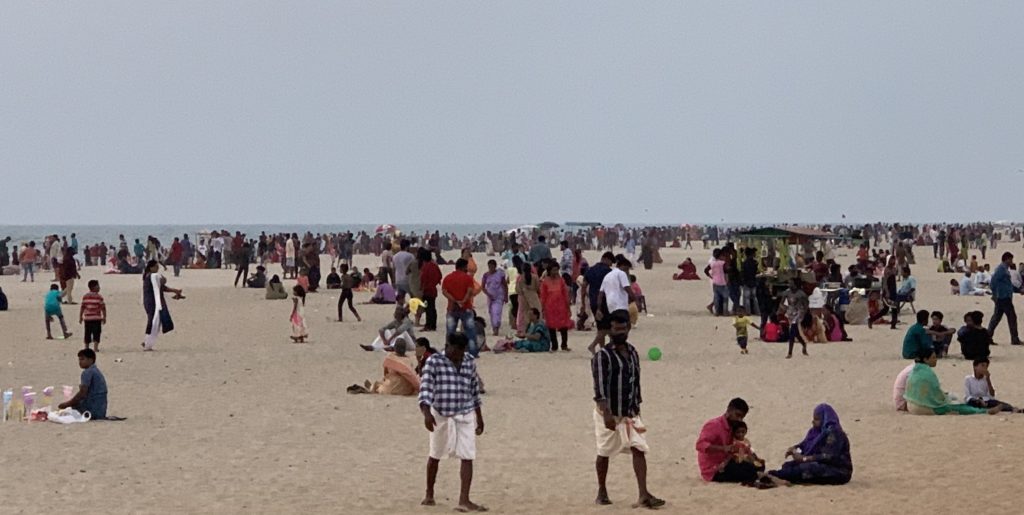
But you are not coming to Alleppey for the beach. Alleppey has become the poster star of Kerala because this is the best place to access the backwaters, a 1,500km network of canals, thirty-eight rivers and five large lakes that together stretch from above Cochin to below Varkala. It should be possible to boat all the way, but these days the routes from Cochin to Alleppey and Kollam to Varkala are blocked.
Alleppey has built its central place in world tourism by offering for rent as many as 1,500 houseboats of teak bones and bamboo skins in varying sizes from one bedroom up, each with two crew (a navigator and a cook). These houseboats do exactly what it says on the tin: they are little houses on boats. The helm is always at the front, just ahead of sofas and a dining table, the bedrooms with hotel-style en suite bathrooms are in the middle, with the kitchen and crew quarters at the back; some have an upstairs lounging area partly open to the sun. There are two classes: premier is totally enclosed, and deluxe is exposed at the front, facilitating a much better experience.
Houseboats are hired per 24-hour period. There is no need to book in advance. It is far better to investigate what you are buying. You can go the day before to the official ATDC counter at Houseboat Dock; or you can go at 9am on the day to Finishing Point where you can choose one just ending to start again immediately; or best of all your hotel or tuk-tuk can suggest one of their mates in the trade you can meet any time and they will show you what is available.
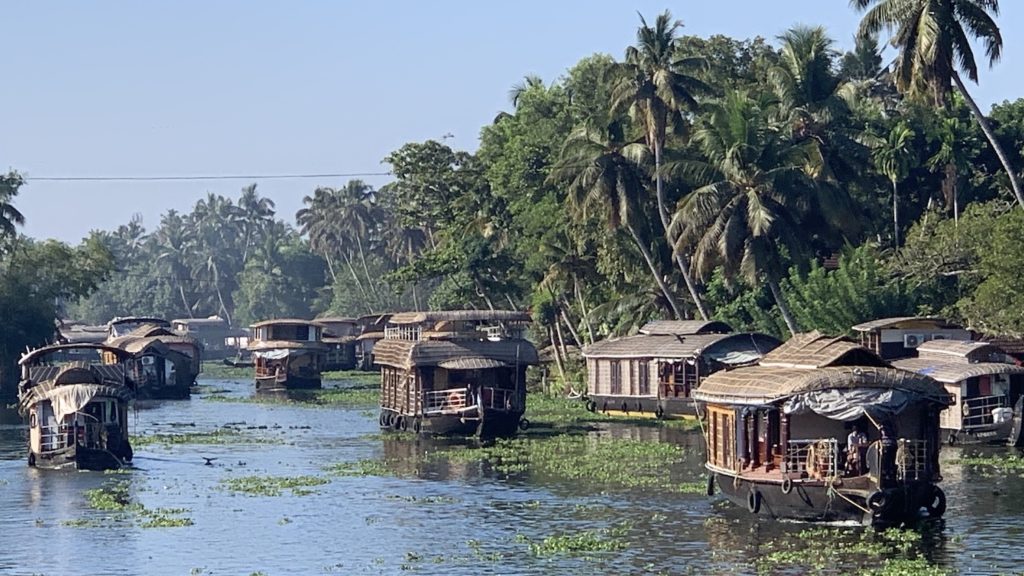
When they first set off, it is certainly true it is a bit of a jam. The initial narrow water is thick with them, sometimes five or six abreast, almost touching, before it opens into Punnamade Lake, where at one point I counted more than forty in view at once. Being part of such an armada is itself entertaining but of course you came here to get away from it all. After lunch it thinned out as the day-trippers turned back, on the second day we saw almost nobody else, and by the third we were completely alone with the very soft purring of the engine slowly bimbling along.
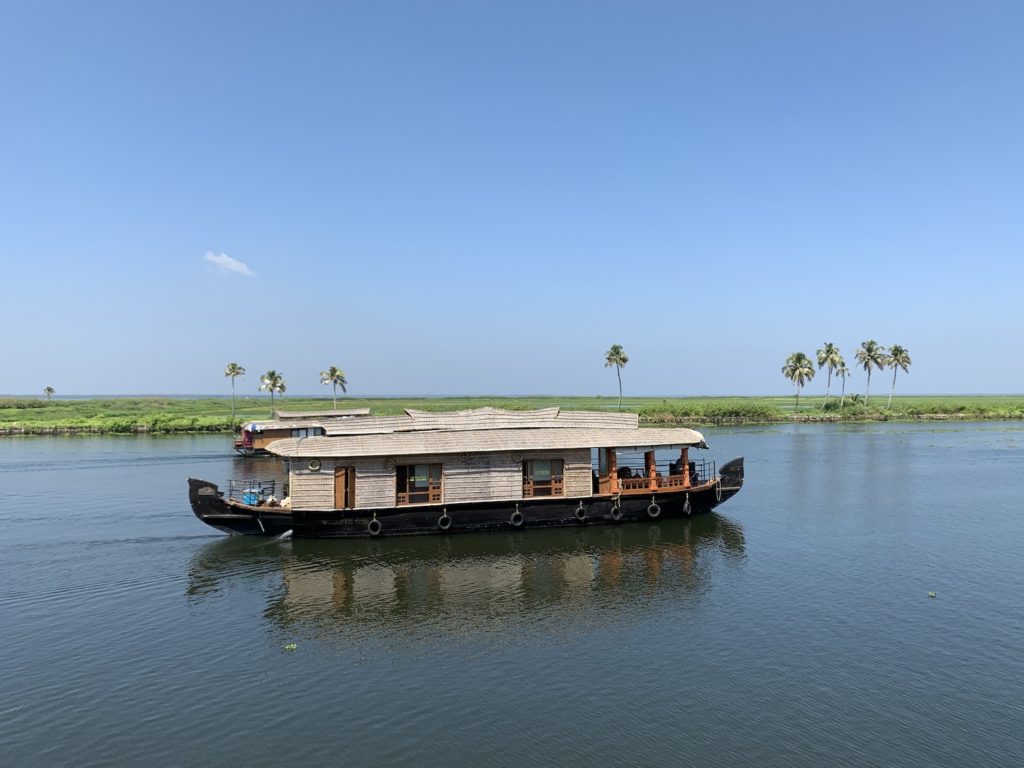
There are arrow-straight canals built to irrigate the paddy fields that are dressed with occasional banana and palm trees; some are haunted by broken stumps, caused by the terrible flooding of 2018 attributable to climate change. There are meandering rivers overgrown by mangroves and overhung by trees. There are calm lagoons where fishermen in long-tail boats hurl nets and sweep up tiger prawns they sell to your cook for later. And there are rosy sunsets over the fronds. But there are no mosquitoes. Bliss.

Conveniently, near Finishing Point and next to a line of day-boats is a rickety ferry that leaves for Kollam (Quilon) at 10.30am every day. It takes 8 hours to go just 90km but of course you get the chance to soak up more of the backwaters, watching people wash pots and pans and laundry and themselves in the rivers while turquoise kingfishers and red kites are on the hunt. Near to the open sea hundreds of seagulls swarm our ferry mistaking it for a trawler.

There is nothing much in Kollam itself. A little packet boat, overloaded with motorbikes and tuk-tuks and taxis as well as pedestrians, nips across the river at Perumon to Munroe Island, a pleasant location to canoe minor backwater tributaries. And back up the coast is the pink Martha Amrithanandamayi Mission, unusual for being an ashram headed by a woman, Amma, the Hugging Mother, who holds all-night greeting sessions, including with tourists. But while I was in Kollam I heard rumours there might be a chance of experiencing one of the most magical if controversial spectacles of India: an elephant parade.
Anayadi, 30km away, amounts to no more than a few dwellings but on the tenth and final day of its annual festival more than 50,000 people from all around – and this year plus maybe a dozen foreigners – descend on the tiny hamlet. Driving there, I could feel elephants assembling, passing some being walked from nearby and some on the backs of trucks being carried from further afield by wealthy families keen to show them off. Getting closer, I could feel chaos gathering too, with so many people crushed into such small spaces, many of them drunk, and many of those on Royal Enfields, which are big all over rural India.
By the side of the roads scores of elephants were being dressed in golden headpieces, and mounted by two, three or even four mahouts or bareback riders holding glittering shields under tassled parasols. Each with its own deafening band of drums and cymbals, the elephants fall into single file. I have felt great energy at big European nights at Old Trafford, and in Hampshire fields at 3am, and this was in that league as the vitality erupted in the afternoon well into the night.
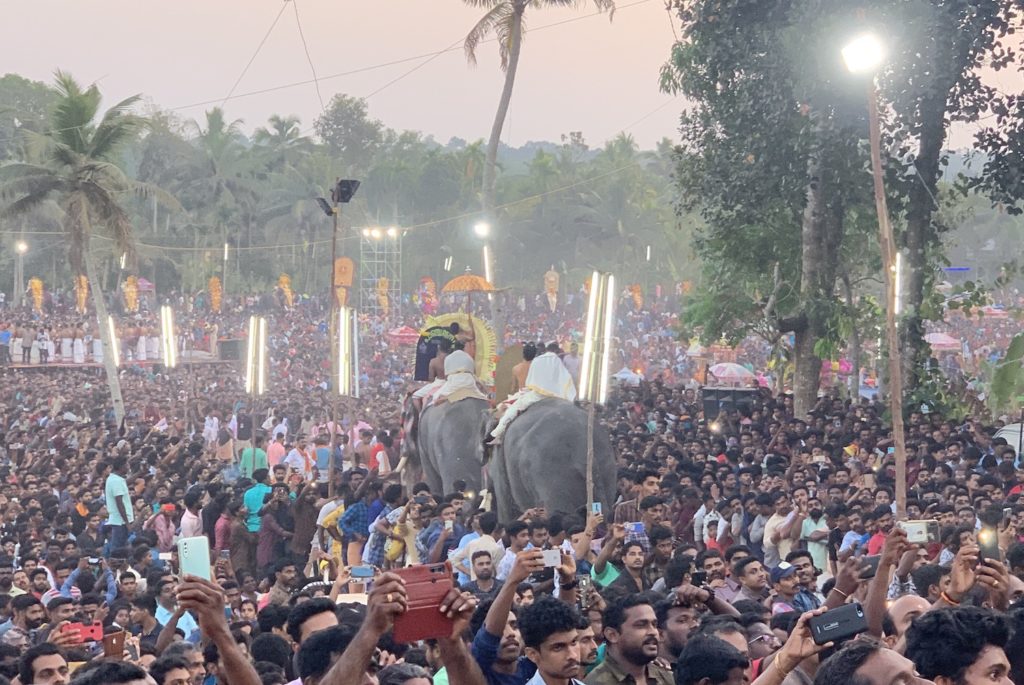
The elephants are walked to the Hindu temple, do a circuit around the courtyard, raise their trunks in salute, and march down in dribs and drabs through a narrow parting in the heaving crowds bursting the nearby fields, before standing smartly in a line at the bottom. The parade lasts four or five hours and it feels like the whole of India has turned out. This is the beautiful bedlam of noisy, smelly, dirty India in full glory assaulting all the senses at once; and at the same time it is a serious concern for animal welfare.

It is 60km from Kollam to Trivandrum (Thiruvanthapuram), a common point of exit. Apart from the intricate Padmanabhaswamy temple there is not a lot here for visitors but nearby are the two best beaches in the state, as close to Goa as Kerala gets, with the attendant pestering, but still comparatively breezy.
Varkala is just north of Trivandrum and although some people do come here for the thirteenth century Janardhanaswami temple (the outside is not much to look at and non-believers are not allowed in), and more come for the yoga retreats and cooking classes that are advertised everywhere, most come for its highly acclaimed beach.
The Gateway Hotel may not be quite to the usual Taj standard but it is certainly the stand-out place here. At the bottom of its garden is a tiny path that pads to the south end of what is properly called Papanasham beach, not far from the Janardhanaswami temple. The sand stretches wide and golden for about a kilometre, and though the water is rough there are parasols and loungers at the north end under the very pretty 20m red wall of cliffs. Steps lead up to a lane of cafes, bars and lodgings above. It is a bit hippie chic and a bit backpacker grime, all self-help-book exchanges and Kashmiri and Tibetan trinket emporiums, but it is still a lovely place to hang out. The path continues north, past several other good beaches, all the way to Kappil, 8km up the coast, and the opening to the most southerly backwaters.
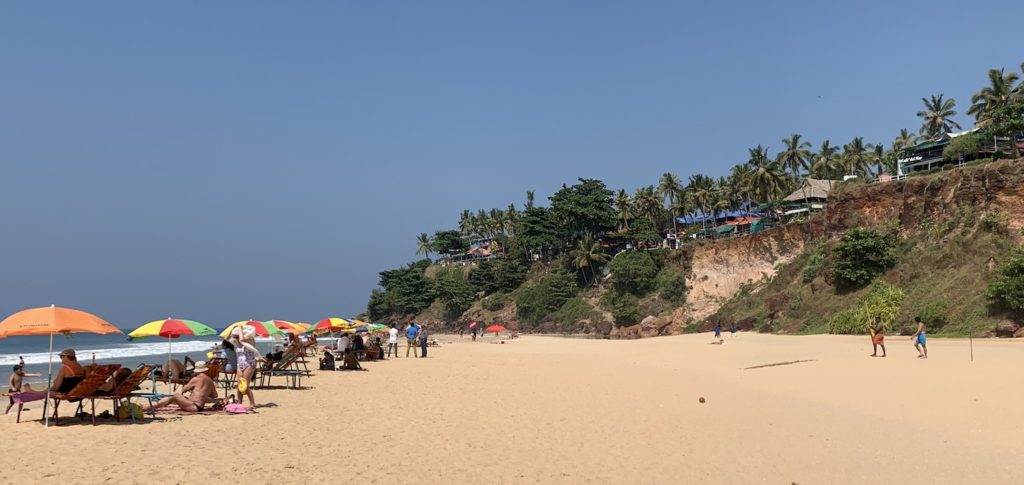
In my view, God’s Own Beach is in fact at Kovalam, a little south of Trivandrum. This is not just the best beach in Kerala, but one of my favourites in the world. There are two short curves of golden sand, lapped by gentle waves, with enough colourful parasols and comfy sunbeds that everyone has one but not so many it feels crowded. The paved path behind leads to buildings offering fresh coconuts, honey and cardamom lassis, newly caught marlin with masala and paratha, made-to-measure cotton trousers and dresses, and seats for watching the sunset. There are also lots of the kinds of ayurvedic centres you see all over Kerala: a somewhat intimate massage, involving a tiny nappy and lashings of oil to get your marmas sorted, is followed by an old-skool steam bath for which you are locked up to the neck in a wooden cabinet to cook.
An iconic red-and-white striped lighthouse is at the south end of the beach and although the excellent Leela Raviz is just off the north end, better located than the Taj Green Cove 5km away, this is one of those occasions when it is better to sacrifice luxury for the sake of being in the heart of the atmosphere. There are plenty of small boutiques on the beach itself to choose from.
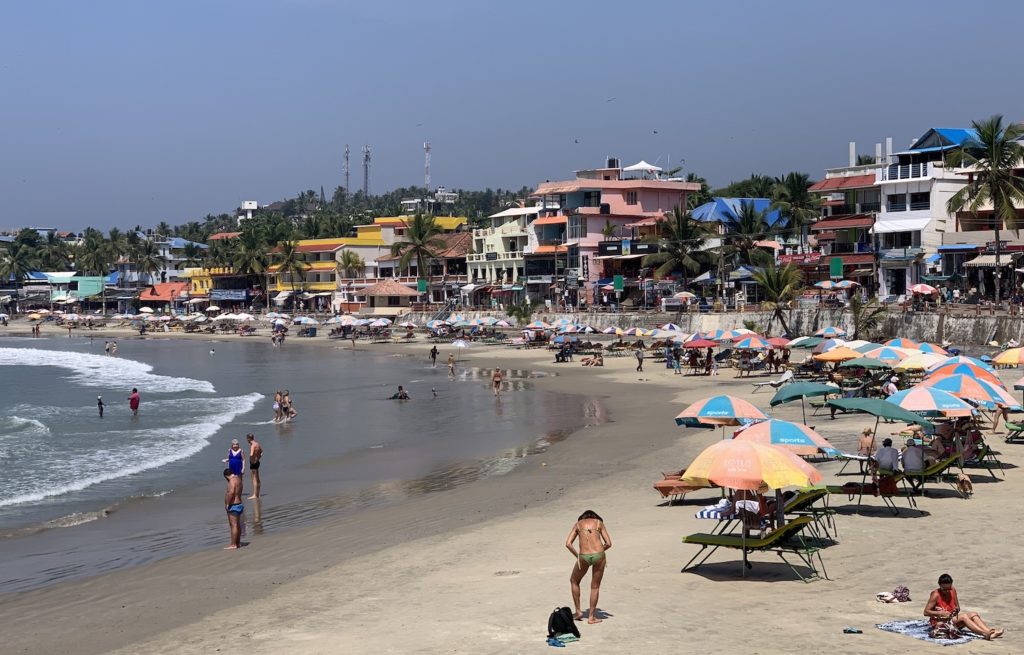
Further south, just half an hour over the border in Tamil Nadu, is the Padmanabhapuram Palace, thought to be a fine piece of Keralan architecture. Only 30km beyond that is Kanyakumari, the tip of South India, where three seas meet. But those are for another trip. Kerala has more than enough to offer without straying off-piste.
